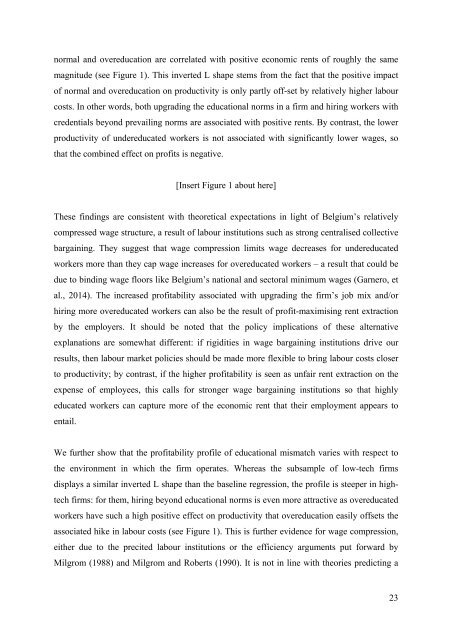CEB Working Paper
240798&r=lma
240798&r=lma
Create successful ePaper yourself
Turn your PDF publications into a flip-book with our unique Google optimized e-Paper software.
normal and overeducation are correlated with positive economic rents of roughly the same<br />
magnitude (see Figure 1). This inverted L shape stems from the fact that the positive impact<br />
of normal and overeducation on productivity is only partly off-set by relatively higher labour<br />
costs. In other words, both upgrading the educational norms in a firm and hiring workers with<br />
credentials beyond prevailing norms are associated with positive rents. By contrast, the lower<br />
productivity of undereducated workers is not associated with significantly lower wages, so<br />
that the combined effect on profits is negative.<br />
[Insert Figure 1 about here]<br />
These findings are consistent with theoretical expectations in light of Belgium’s relatively<br />
compressed wage structure, a result of labour institutions such as strong centralised collective<br />
bargaining. They suggest that wage compression limits wage decreases for undereducated<br />
workers more than they cap wage increases for overeducated workers – a result that could be<br />
due to binding wage floors like Belgium’s national and sectoral minimum wages (Garnero, et<br />
al., 2014). The increased profitability associated with upgrading the firm’s job mix and/or<br />
hiring more overeducated workers can also be the result of profit-maximising rent extraction<br />
by the employers. It should be noted that the policy implications of these alternative<br />
explanations are somewhat different: if rigidities in wage bargaining institutions drive our<br />
results, then labour market policies should be made more flexible to bring labour costs closer<br />
to productivity; by contrast, if the higher profitability is seen as unfair rent extraction on the<br />
expense of employees, this calls for stronger wage bargaining institutions so that highly<br />
educated workers can capture more of the economic rent that their employment appears to<br />
entail.<br />
We further show that the profitability profile of educational mismatch varies with respect to<br />
the environment in which the firm operates. Whereas the subsample of low-tech firms<br />
displays a similar inverted L shape than the baseline regression, the profile is steeper in hightech<br />
firms: for them, hiring beyond educational norms is even more attractive as overeducated<br />
workers have such a high positive effect on productivity that overeducation easily offsets the<br />
associated hike in labour costs (see Figure 1). This is further evidence for wage compression,<br />
either due to the precited labour institutions or the efficiency arguments put forward by<br />
Milgrom (1988) and Milgrom and Roberts (1990). It is not in line with theories predicting a<br />
23


